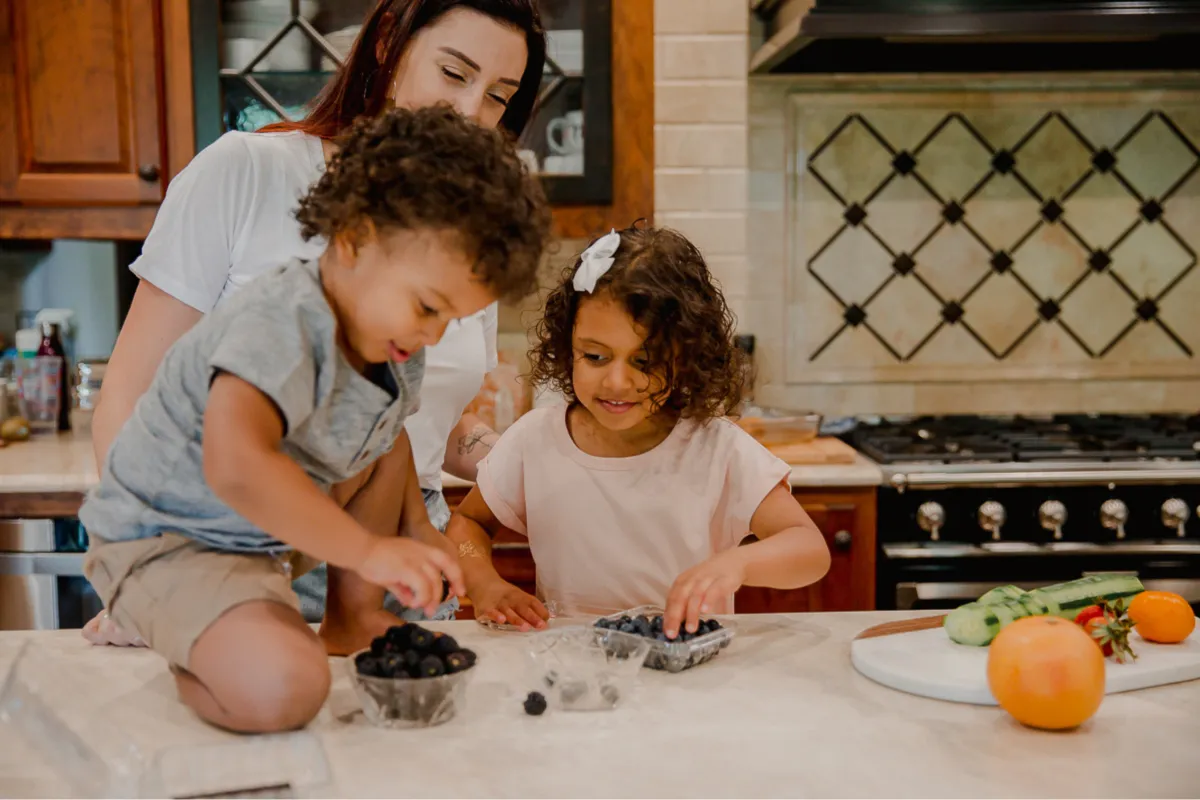Blog

Heavy Metals & Fruit Juice: What You Need to Know
“Juice! Juice!” - JackAttack as soon as we hit the bottom stair every morning.
I mean, what kid doesn’t love juice. Honestly.
But, for a long time we’ve been well aware of how much sugar fruit juice contains. Take a popular orange juice brand, for example, 1 cup has 22 grams of sugar. Or take a household name brand of apple juice- 1 cup has 28 grams of sugar. To put that into perspective, the average 5-year-old should consume less than 19 grams of sugar per day. I can’t help myself, one more. Grape juice? I’m not naming brand names but.. 36 grams of sugar per cup.
Comparing the sugar in fruit juice to whole fruit.. a medium orange has 12 grams of sugar, whereas the juice has double the amount of sugar. A cup of grape juice is equivalent to eating over 50 grapes.
Welp, there goes all of your sugar intake in one cup o’ juice. And it’s not even 9am.
It’s not new. Numerous studies link increased consumption of fruit juice to higher risk of type 2 diabetes. While greater consumption of whole fruits, particularly blueberries and apples, is directly associated with a lower risk of type 2 diabetes.
I digress, sugar isn’t even what I wanted to talk about here. But hey, worth it to mention.
What I really want to talk about is heavy metals in fruit juice.
Last year, Consumer Reports tested 45 well known fruit juices sold across the United States- including grape, pear, apple, and fruit blends. The study focused on detecting levels of cadmium, lead, mercury, & inorganic arsenic because they pose some of the greatest threats to our health.
In the report, Dr. Jennifer Lowry, M.D., who is a chairperson of the American Academy of Pediatrics’ Council on Environmental Health, explains that the exposure of any of these metals early in life can impact a child’s entire life trajectory. The findings...drum roll please…almost half of the popular fruit juices tested contained heavy metals. HALF
Of the 45 juices, 22 apple juices were tested, 13 fruit juice blends, 7 grape juices, and 3 pear. Most of the juices were from concentrate, meaning, the water was removed from the pressed fruit for transporting and then added back in at the factory.
Twenty four brands were represented, including: Whole Foods’ 365 Everyday Value, Apple & Eve, Rite Aid’s Big Win, Capri Sun, Dollar General’s Clover Valley, Walmart’s Great Value, Gerber, Good2Grow, CVS’ Gold Emblem, Goya, Honest Kids, Juicy Juice, Looza, Target’s Market Pantry, Minute Maid, Mott’s, Nature’s Own, Ocean Spray, Old Orchard, R.W. Knudsen, Target’s Simply Balanced, Tree Top, Trader Joe’s, Treep Top, & Welch’s.
To break down the findings…
Measurable amounts of at least one of the tested heavy metals (cadmium, inorganic arsenic, lead, or mercury) were found in every product.
47% of the juices contained concerning levels of cadmium, inorganic arsenic, and/or lead.
26% could pose health risks to children who drink half a cup or more per day.
43% could pose health risks to kids who drink one cup or more per day.
Grape juice & juice blends contained the highest average of heavy metal levels
Organic juices did not have lower levels of heavy metals than conventional juices tested
Consumer Reports Chief Scientific Officer, Dr. James Dickerson, concluded that just drinking 4 ounces (i.e. half of a cup) is enough cause for concern. In a survey of more than 3,000 parents, 74% report their kids drink juice more than once per day.
So, how can these heavy metals harm us?
The harmful effects of heavy metals are well documented.
Inorganic Arsenic is acutely toxic. The ingestion of large doses can lead to gastrointestinal symptoms, cardiovascular disturbances, & nervous system dysfunction. These high doses may also result in encephalopathy, hepatomegaly, polyneuropathy & haemolysis. In terms of chronic exposure to lower doses, the evidence is strongest for causing hypertension, cardiovascular disease, diabetes, reproductive dysfunction, neurological effects, & lung, bladder, and kidney cancer.

Exposure to high levels of lead can cause abdominal pain, fatigue, irritability, memory loss, constipation, generalized weakness, anemia, & kidney and brain damage. Lead has the ability to cross the placental barrier, meaning, if a pregnant woman is exposed to any amount of lead - their unborn child is also exposed. Even at low levels, exposure to lead can cause miscarriages, stillbirths, infertility, & behavioral consequences.
Prolonged exposure to lead, even at small doses, may also lead to depression, distractibility, forgetfulness, nausea, high blood pressure, heart disease, & kidney disease.
Chronic exposure to low levels of cadmium can result in kidney, bone, & lung disease. Whereas mercury, a neurotoxin, can cause skin rashes, mood swings, memory loss, mental disturbances, muscle weakness, muscular atrophy, headaches, tremors, insomnia, impaired speech, & loss of peripheral vision. The list goes on.
The moral of the story here is that these heavy metals can cause lowered IQ, behavioral problems (ADHD), diabetes, cancer, & so much more.
There are a few established limits put in place for reducing exposure to these heavy metals. Back in 2013, the FDA responded to a Consumer Reports study by proposing a limitation on inorganic arsenic in apple juice to 10 parts per billion (ppb) - which is the federal arsenic standard for drinking water. This limit is still not in place.
In this study, all but one of the juices had inorganic arsenic levels below the proposed 10ppb limit.
As for lead, the current FDA guideline is 50ppb. To put it into perspective, the standard for lead in bottled water is 5ppb. How does that make sense? It doesn’t, to me.
I mean, I don’t want my child to drink lead, period.
To me, there is no “safe” level of any of these heavy metals. Why? Because no one is considering bioaccumulation. Chemical and food industries are able to get by on the fact that ‘small amounts of toxins are harmless to the body’. But they neglect to consider that since we do not totally detoxify those everyday ‘harmless’ amounts of chemicals and metals that we ingest, they are simply stockpiling (bioaccumulating) in our tissues. Our bodies were not meant to process them.
These metals are not only in our juice. They’re in infant and toddler foods, rice and rice products, protein powder, fish, water, air, & soil. Which means we are exposed to these ‘trace’ or ‘safe’ amounts all the freaking time.
The risk here comes from chronic exposure. Minimizing the consumption of juices and other foods that contain these heavy metals can significantly reduce the risk of adverse health effects for your little human.
So, What Can We Do?
Limit fruit juice
If drinking fruit juice, substitute juice for a less toxic option
Consider replacing juice with something else (see below)
If continuing to drink juice, you may want to consider eliminating the juices the study found to be highest in cadmium, inorganic arsenic, lead, and/or mercury. These include:
Minute Maid’s 100% Juice Apple Juice
Juicy Juice’s Apple Juice Box
Minute Maid 100% juice Fruit Punch
Trader Joe’s Apple Juice Box
Welch's 100% Juice with Antioxidant Superberry
Great Value (Walmart) 100% Juice, Cranberry Grape
Welch's 100% Grape Juice, White Grape
Welch's 100% Grape Juice, Concord Grape
R.W. Knudsen Organic Just Concord Grape Juice
365 Everyday Value (Whole Foods) Organic 100% Juice, Concord Grape
Trader Joe's Fresh Pressed Apple Juice, 100% Juice
Trader Joe's Organic Apple Grape Juice
Juicy Juice 100% Juice, White Grape
Great Value (Walmart) 100% Juice, Cranberry Grape
365 Everyday Value (Whole Foods) Organic 100% Juice, Grape Cranberry
R.W. Knudsen Organic Pear 100% Juice
Gold Emblem (CVS) 100% Grape Juice
Gerber White Grape Juice
365 Everyday Value (Whole Foods) Organic 100% Juice, Concord Grape
Trader Joe's Organic Apple Juice
Great Value (Walmart) 100% Juice, Apple
Gold Emblem (CVS) 100% Apple Juice
Better options the study found are:
365 Everyday Value (Whole Foods) Organic Apple Juice, 100% Juice
Goya Pear Nectar
Looza Pear Juice Drink
Simply Balanced (Target) Organic Apple Juice, 100% Juice
Juicy Juice Organics 100% Juice, Apple
Honest Kids Organic Juice Drink, Goodness Grapeness

Another great option, and my personal favorite, is to make your own ‘juice’. This is what we do in our home. We take a big pitcher of (filtered) water with ice and add some slices of organic lemon, strawberries, & a few basil leaves. Stir it up. Let it sit in the fridge overnight and, voilà, juice!
Sometimes we get a little crazy and switch up the fruits - blueberries, blackberries, oranges, you name it.
My kids love it. It’s refreshing, tasty, and JackJack approved. I mean the kid tugs it out of the refrigerator door.
The Discovery Doc - Dr. CeCe Brooks - Atlanta Holistic NP
Copyright 2022 The Discovery Doc, LLC®. All Rights Reserved.




